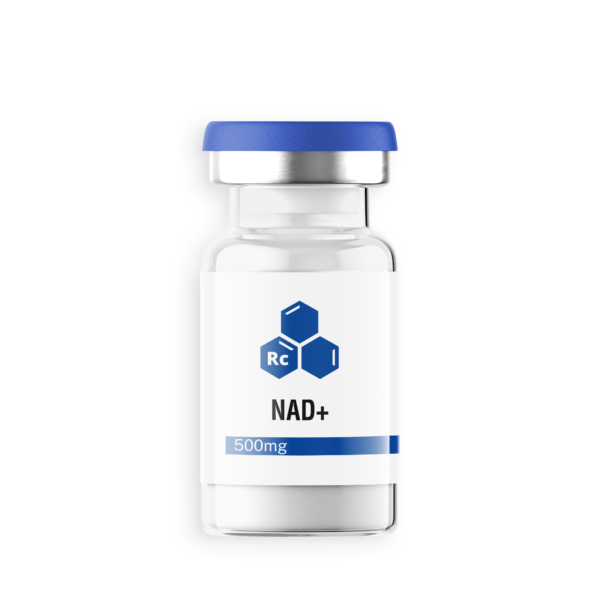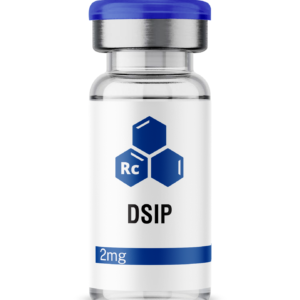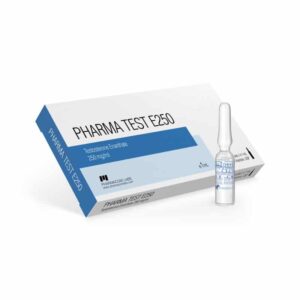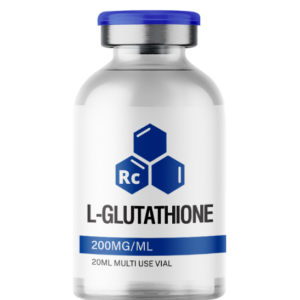Description
NAD+ (Nicotinamide Adenine Dinucleotide) – 500mg
General Information
Nicotinamide Adenine Dinucleotide (NAD+) is a prevalent cellular electron transporter, coenzyme, and signaling molecule found in all cells of the body and is vital for cell function and viability. Its reduced (NADH) and phosphorylated forms (NADP+ and NADPH) are as important as NAD+. Each step of cellular respiration—glycolysis in the cytoplasm, the Krebs cycle, and the electron transport chain in the mitochondria—requires the presence of NAD+ and NADH, their redox partner.
The manufacture of cholesterol and nucleic acids, elongation of fatty acids, and regeneration of glutathione, a vital antioxidant in the body, are just a few anabolic processes that frequently require NADP+ and NADPH. NAD+-dependent/-consuming enzymes modify proteins post-translationally in various cellular processes using NAD+ and its other forms as substrates. NAD+ also acts as a precursor for cyclic ADP ribose, an essential component of calcium signaling and a secondary messenger molecule.
The amino acid tryptophan and the vitamin precursors nicotinic acid and nicotinamide, often known as vitamin B3 or niacin, are used by the body to naturally produce NAD+. It can also be produced from biosynthetic intermediates including nicotinamide mononucleotide and nicotinamide riboside. NAD+ is continuously recycled within cells as it transitions between its many forms through salvage mechanisms. Mammalian cells may be able to take up extracellular NAD+, according to studies on cell culture.
The highest NAD+ levels are found in neonates, and they gradually decrease with increasing chronological age. They are around half of what they are in younger persons after age 50. Model organisms have been used to study the subject of why NAD+ levels fall with aging. However, during other metabolic activities, NAD+ is consumed by NAD+-dependent enzymes and may subsequently become depleted over time, contributing to increased DNA damage, age-related illnesses and diseases, and mitochondrial malfunction. During redox reactions, NAD+ and NADH are not consumed but rather continually regenerated. Views of aging and senescence frequently highlight a deterioration in mitochondrial health and function with age, and investigations of NAD+ depletion and the associated oxidative stress and damage corroborate these theories.
The age-related drop in NAD+ levels is caused by rising levels of CD38, a membrane-bound NADase that degrades both NAD+ and its precursor nicotinamide mononucleotide, according to a 2016 study in mice, which exhibit age-related declines in NAD+ levels similar to those seen in humans. The study also demonstrated that human adipose tissue from older adults (mean age, 61 years) expresses the CD38 gene at higher levels than that of younger adults (mean age, 34 years). Other research in mice, however, has shown that oxidative stress and inflammation brought on by aging lower NAD+ production. Therefore, it is likely that a number of mechanisms work together to cause individuals to lose NAD+ as they age.
When it was recognized that pellagra, a condition marked by diarrhea, dermatitis, dementia, and mortality, could be treated with foods containing NAD+ precursors, particularly vitamin B3, the clinical significance of maintaining NAD+ levels was established in the early 1900s. Notably, the skin does not flush with NAD+ injection, in contrast to vitamin B3 (niacin) intake, which also causes this negative effect. Low NAD+ levels have recently been associated with a variety of age-related ailments and diseases linked to increased oxidative/free radical damage, including diabetes, heart disease, vascular dysfunction, ischemic brain injury, Alzheimer’s disease, and vision loss.
Nicotinamide Adenine Dinucleotide
Since a 1961 report by Paul O’Hollaren, MD, of Shadel Hospital in Seattle, Washington, NAD+ IV infusion has been widely utilized for the treatment of addiction. In more than 100 instances, Dr. O’Hollaren detailed the effective use of IV-infused NAD+ for the prevention, relief, or treatment of acute and chronic symptoms of addiction to a range of substances, including alcohol, heroin, opium extract, morphine, dihydromorphine, meperidine, codeine, cocaine, amphetamines, barbiturates, and tranquilizers. The security and effectiveness of NAD+ treatment for addiction, however, have not yet been assessed in clinical trials.
NAD+-replacement therapy may encourage optimal mitochondrial function and homeostasis, genomic stability, neuroprotection, long life, and may help with addiction treatment. Clinical trials assessing these effects in humans receiving NAD+ injection have not yet been published; nevertheless, many clinical trials assessing the effectiveness and safety of NAD+-replacement therapy or augmentation in the context of human disease and aging have recently been completed, and many more are currently underway.
Nicotinamide Adenine Dinucleotide
Storage
Store dry powder at 68°F to 77°F (20°C to 25°C) and away from heat, moisture and light. Once reconstituted keep this medicine in a refrigerator between 36°F to 46°F (2°C to 8°C). Keep all medicine out of the reach of children. Throw away any unused medicine after the beyond-use date. Do not flush unused medications or pour down a sink or drain.
Adverse Reactions/Side Effects
Injection of NAD+ seems to be secure and well-tolerated. The injection of NAD+ may cause adverse reactions and side effects, such as headache, shortness of breath, constipation, increased plasma bilirubin, and decreased levels of gamma glutamyl transferase, lactate dehydrogenase, and aspartate aminotransferase.
Case studies of the use of NAD+ to treat drug addiction offered early information on side effects and safety. According to a 1961 study, patients with addiction who got NAD+ at a moderate IV drip rate (no more than 35 drops per minute) reported “no distress” but those who received it at a quicker drip rate complained of headache and shortness of breath. In this study, the dosage was 500–1000 mg per day for 4 days, then two injections every week for a month, and then one injection every two months as a maintenance dose. One of the two patients who had therapy reported experiencing constipation.
In a 2019 study, a cohort of healthy male participants (n=11; NAD+ n = 8 and Control n = 3) aged 30-55 years had their safety of IV infusion of NAD+ evaluated using liver function tests (serum, total bilirubin, alkaline phosphatase, alanine aminotransferase, gamma glutamyl transferase, lactate dehydrogenase, and aspartate aminotransfer. Neither the NAD+ cohort nor the placebo (saline) cohort experienced any negative side effects throughout the 6 hour infusion. At 8 hours following the start of the NAD+ infusion, it was shown that the NAD+ group had significant declines in the liver function enzymes gamma glutamyl transferase, lactate dehydrogenase, and aspartate aminotransferase as well as a large increase in plasma bilirubin. The modifications, however, were not regarded as clinically important. Because of the limited sample sizes, notably for the control group, which are acknowledged by the authors, these results should be evaluated with care.
Interactions
At the time of writing, there were no reported interactions for NAD+ injection. It is possible that unknown interactions exist.
Breastfeeding
The safety of NAD+ injection has not been evaluated in women who are breastfeeding or children. Due to this lack of safety data, women who are breastfeeding and children should avoid NAD+ injection.
Contraindications/Precautions
At the time of writing, there were no other reported contraindications/precautions for NAD+ injection. Individuals with known allergy to NAD+ injection should not use this product.
Pregnancy
The safety of NAD+ injection has not been evaluated in pregnant women. Due to this lack of safety data, pregnant women should avoid NAD+ injection.
Nicotinamide Adenine Dinucleotide
Restricted Product
-20%








Reviews
There are no reviews yet.